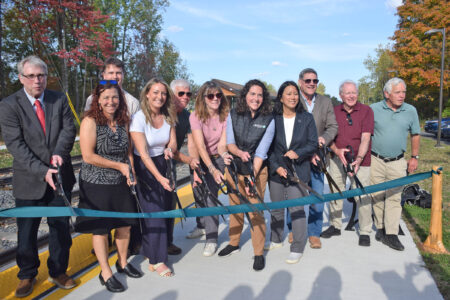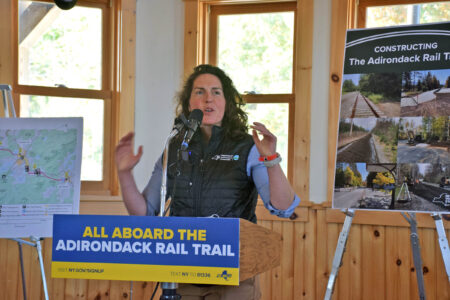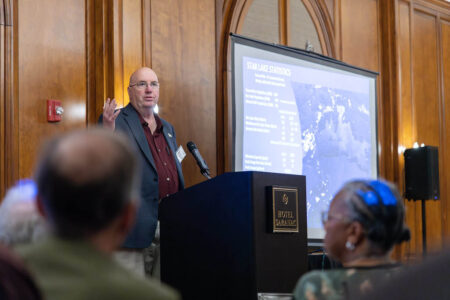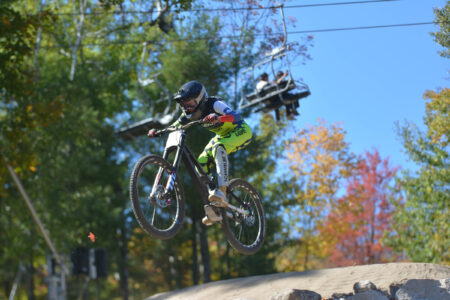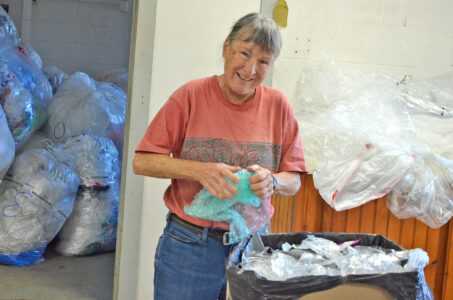Rail trail offically opens in full capacity
- State and local officials, along with rail trail stakeholders, are seen at the Tupper Lake train station on Saturday, cutting the ribbon to officially open the third and final phase of the Adirondack Rail Trail. From left are state DOT Region 7 Director Robert Haynes, ARTA Executive Director Julia Goren, state DEC Region 5 Director Joe Zalewski, Tupper Lake village Mayor Mary Fontana, former DEC Commissioner and current state ORDA Board Chair Joe Martens, state Office of Parks, Recreation and Historic Preservation Acting Commissioner Kathy Moser, DEC Commissioner Amanda Lefton, state OGSeCommissioner Jeanette Moy, Tupper Lake town Supervisor Rickey Dattola, ARTA Board member Lee Keet and former Adirondack Trail Improvement Society Executive Director and Keene town Historian Tony Goodwin. (Enterprise photo — Chris Gaige)
- State Department of Environmental Conservation Commissioner Amanda Lefton speaks inside the Tupper Lake train station at the ribbon-cutting ceremony to officially open the third and final phase of the Adirondack Rail Trail, a 34-mile multi-use trail along the old railway from Tupper Lake, at the west end, to Lake Placid, at the east end. (Enterprise photo — Chris Gaige)
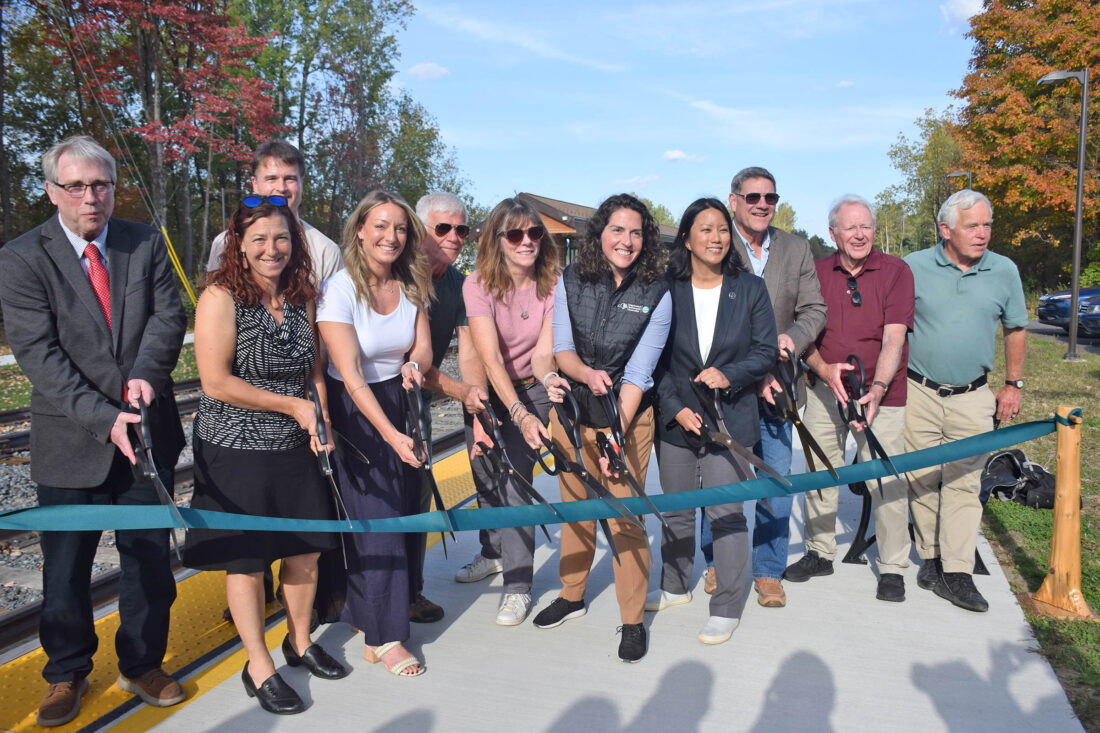
State and local officials, along with rail trail stakeholders, are seen at the Tupper Lake train station on Saturday, cutting the ribbon to officially open the third and final phase of the Adirondack Rail Trail. From left are state DOT Region 7 Director Robert Haynes, ARTA Executive Director Julia Goren, state DEC Region 5 Director Joe Zalewski, Tupper Lake village Mayor Mary Fontana, former DEC Commissioner and current state ORDA Board Chair Joe Martens, state Office of Parks, Recreation and Historic Preservation Acting Commissioner Kathy Moser, DEC Commissioner Amanda Lefton, state OGSeCommissioner Jeanette Moy, Tupper Lake town Supervisor Rickey Dattola, ARTA Board member Lee Keet and former Adirondack Trail Improvement Society Executive Director and Keene town Historian Tony Goodwin. (Enterprise photo — Chris Gaige)
TUPPER LAKE — It’s official. The 34-mile Adirondack Rail Trail from Lake Placid in the east to Tupper Lake in the west is fully open for year-round use.
State and local officials, along with rail trail advocates and stakeholders, held a ribbon-cutting ceremony at the Tupper Lake train station Saturday afternoon to mark the occasion, as well as to celebrate the recently-complete renovations to the train station there. The station serves as the northern terminus for the scenic Adirondack Railroad, which originates in Utica and includes stops at Remsen and Thendara/Old Forge.
There were speakers from three state agencies involved in the project — the state Department of Environmental Conservation, Department of Transportation and Office of General Services — and the Adirondack Rail Trail Association.
The completion caps off several years of work — done in three phases — to remove old rail tracks and build a multi-use recreation trail along the rail bed, with a crushed stone and gravel base beneath a compacted fine stone dust surface. Though it’s not paved for the most part, its even surface, relatively gentle grade and construction of access points have made the trail ADA-compliant.
The removal of old rail tracks began in 2020 and trail construction began in November 2022 in the Lake Placid to Saranac Lake corridor. That was completed in December 2023. Phase two, from Saranac Lake to Floodwood Road in the town of Santa Clara, began in June 2023 and was finished in August 2024. The third phase’s construction, from Floodwood Road to Tupper Lake, began in August 2024. While the trail is open, there is still some minor ongoing work, such as putting up mileage signs, that is expected to continue along the third phase this fall.
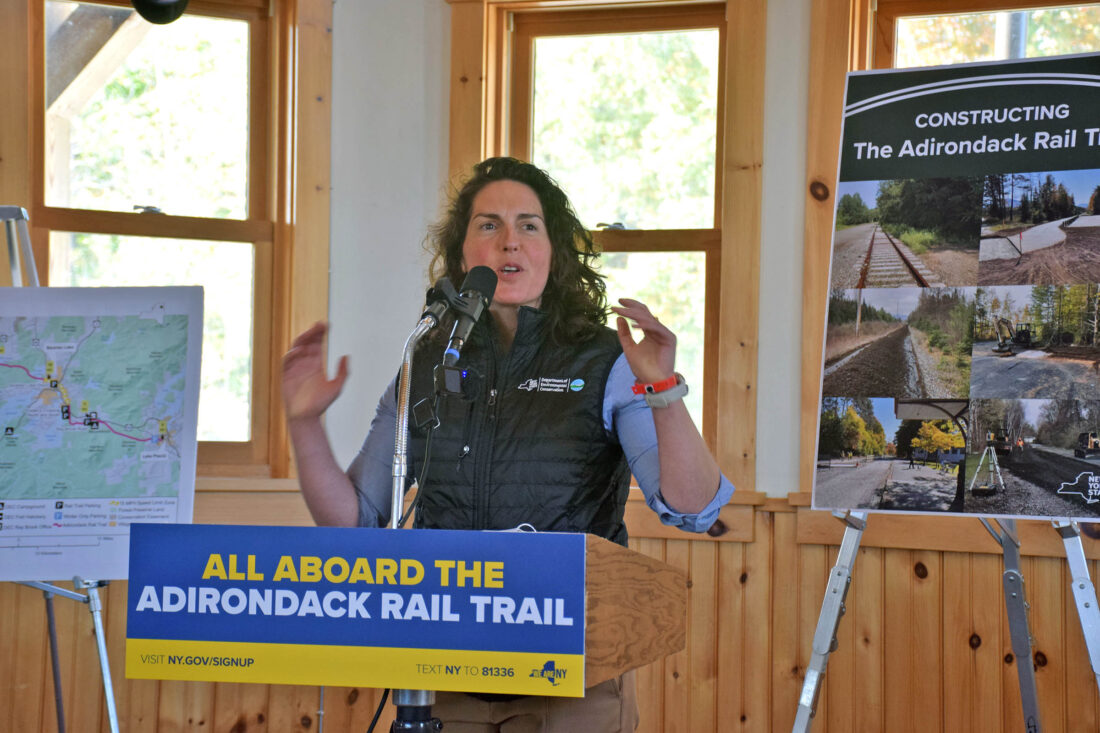
State Department of Environmental Conservation Commissioner Amanda Lefton speaks inside the Tupper Lake train station at the ribbon-cutting ceremony to officially open the third and final phase of the Adirondack Rail Trail, a 34-mile multi-use trail along the old railway from Tupper Lake, at the west end, to Lake Placid, at the east end. (Enterprise photo — Chris Gaige)
The rail trail cost nearly $40 million to build, according to a statement from Gov. Kathy Hochul announcing its completion. Hochul was initially rumored to have been at the ribbon-cutting, which sparked calls for protest from conservative organizers, and in turn, called for counterprotests from liberal organizers on social media. Ultimately, Hochul did not attend the ceremony. While there were some protesters from both sides before the ceremony, there were no disruptions it, which drew a crowd of about 100.
DEC Region 5 Director Joe Zalewski served as the event’s emcee, and DEC Commissioner Amanda Lefton was the first to give prepared remarks. She began by acknowledging the decades of work that went into making the rail trail — and the rehabilitated railway from Remsen to Tupper Lake — a reality.
“We are here today to celebrate phase three of the rail trail being completed,” she said. “This is really an incredible milestone today, having completed the entire rail trail which unites the communities of Lake Placid, Saranac Lake and Tupper Lake through a 34-mile accessible trail that highlights the unique charms and beauties of the Adirondacks.”
Lefton was especially proud of the rail trail being built to ADA standards, which she said furthers the mission of making sure that access to these lands is for everyone, regardless of ability. She added that the trail was a world-class asset, and one that is fairly unique to the Adirondacks in terms of how many outdoor activities it can support over such a long distance, with direct access to wild lands.
“It’s going to be open to bicycles, hikers, runners, birders and so many more,” she said.
Additionally, the trail is open to cross-country skiers and snowmobilers in the winter. The trail is free to use and is maintained in partnership between the DEC and ARTA through a volunteer stewardship agreement.
In her remarks, state Office of General Services Commissioner Jeanette Moy praised Hochul’s commitment to the project. OGS oversaw the contracts and bidding associated with the project.
“Three years ago, Governor Hochul, under her direction, asked that our agency move full speed ahead with this project,” Moy said. “She wanted to make sure that the concept wasn’t just being discussed (but) that we were putting it into action.”
DOT Region 7 Director Robert Haynes highlighted the $13.5 million project to upgrade the historic Tupper Lake train station. These include a new train platform, a maintenance facility and rehabilitated track. He also lauded his department’s collaboration, and said this ribbon cutting was different than most of the ribbon cuttings he attends.
“Usually, the DOT is at an event celebrating bridges and roads, but today is different,” he said. “We’re celebrating partnership the DEC, with OGS and with many local governments. We’re talking about economic development and tourism. I’d like to thank our partners at DEC, OGS and those locals for helping us make this a successful event. This is a special day and one that is worth celebrating.”
ARTA Executive Director Julia Goren highlighted the work between local governments, including the village and town of Tupper Lake, town of Santa Clara, town of Harrietstown, village of Saranac Lake, town of North Elba and village of Lake Placid, and the individuals who advocated for it. She added that trail counters have recorded 229,000 uses since they were installed in 2024.
“This trail is here today because of your foresight, persistence and collaboration,” Goren said. “This project happened because a group of individuals had a vision for our communities — that with a world-class recreational asset, we would have healthier families, stronger local businesses and a sustainable tourism economy that reflects the best of the Adirondacks.”
The final speaker was Joe Martens, the former DEC commissioner who oversaw the rail trail project’s inception. He gave a shoutout to his then counterpart, former DOT Commissioner Joan McDonald. He recalled when the two rode the corridor together 20 years ago, taking a train to the southern end, then a high roller to Lake Placid. Martens said they spent copious amounts of time poring over reports from railroad and rail trail advocates before agreeing to split the corridor and meet in Tupper Lake. He said it was proof that compromise is still possible.
“For all the angst around the world these days and the division, this has brought people together — it’s brought the rail community with the trail community,” he said. “It’s brought health benefits. There’s a lot of people who can’t hike the High Peaks in the Adirondacks. … But people can handle the rail trail, and they can experience the wilderness without having to hike a million miles to do it.
“When I go out on the rail trail, I see persons with disabilities, I see mothers and fathers with carriages and small children, and once again, they’re all smiling,” he said. “It is a phenomenal resource and I cannot say enough about all of the people who had a role, and all of the volunteers.”
Martens added that it wasn’t cheap, but it was money “extraordinarily well spent.” And now that the trail was officially built, he had a simple message to those in attendance.
“Go out and enjoy it, and enjoy life.”

